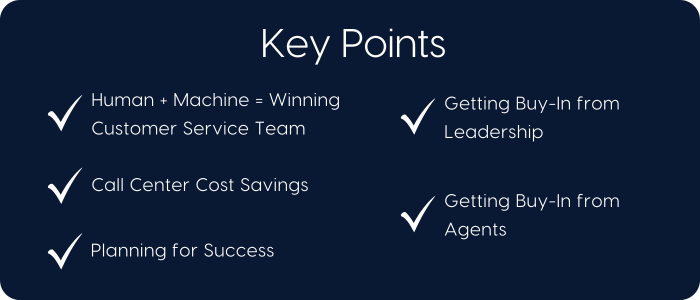Artificial Intelligence (AI) and Large Language Models (LLMs) are already being used by all types of businesses. Research indicates that 77 percent of companies are either using or exploring the use of AI in their businesses, and 83 percent of companies report that AI is a top priority in their business plans.
AI and LLMs are already making waves in call centers, and for good reason. This newest development has the potential to increase productivity without taking away human jobs and turn an initial financial investment in technology into a cost-effective decision.

Human + Machine = Winning Customer Service Team
It’s understandable that people are wary of losing their jobs or having their hours reduced because a machine can “do it better.” However, that doesn’t have to happen in the contact center industry. When viewed as co-workers or teammates, AI and LLMs can make great agents into super agents.
Most of us would like a little extra help at work. It is well-known that being a call center agent can be a stressful job, and oftentimes experience burnout. LLMs are more like super-powered assistants to the operators. LLMs can provide real-time information retrieval, suggest responses, and even complete forms during calls to significantly reducing handling times. This technology offers solutions for faster resolution times and happier callers.
AI and LLMs can boost efficiency and productivity by relieving some of the operator’s workload. This technology can:
- Automate repetitive tasks by handling data entry, call summaries, and even generating reports, freeing up agents for more complex issues. This makes agents available for complex problem-solving and customer service interactions.
- Provide smarter self-service by powering advanced chatbots that understand natural language and context. This means callers get accurate answers to frequently asked questions without interrupting an agent.
- Improve first contact resolution times by equipping agents with the right information and suggested responses, leading to a higher chance of resolving issues on the first call and boosting customer satisfaction.
- Offer personalized interactions by analyzing customer data and tailoring communication styles for better engagement.
- Provide caller sentiment analysis by analyzing conversation tone to identify frustrated customers and flag them for priority handling or even de-escalate situations.
Call Center Cost Savings
Implementing AI and LLM solutions requires an upfront investment in technology and training. However, the long-term cost savings are projected to outweigh these initial costs.
AI and LLMs are expected to offer significant cost savings for call centers in several ways. As it was mentioned earlier, this technology won’t completely replace humans, but it still does offer reduced labor costs because some tasks can be done by automation.
LLM-powered chatbots can also answer basic questions 24/7, deflecting calls to reduce staffing needs. Automation and increased availability can potentially lead to reducing overall labor costs.
Streamlined call handling leads to shorter call durations and lower overall costs. LLMs can equip agents with the right information to resolve issues on the first call, which reduces the need for repeat calls, saving time and resources.
Overall, AI and LLMs are expected to be a net positive for call center costs. However, it’s important for call centers to carefully plan their AI implementation to maximize the benefits and minimize potential disruptions.

Planning for Success
Alexander Graham Bell said, “Before anything else, preparation is the key to success.” Below are five steps to help contact center leadership get started with developing a plan to implement AI and LLMs.
- Identify Needs and Goals:
- Define areas where AI and LLMs can offer the most significant benefit. Consider factors like cost reduction, improved caller satisfaction, and agent productivity.
- Set clear and measurable goals for your AI implementation. This could include targets for increased FCR, reduced call handling times, or improved caller satisfaction scores.
- Research and Choose the Right Solution(s):
- Explore different AI and LLM solutions available, considering factors like functionality, scalability, vendor support, and cost.
- Look for solutions that integrate seamlessly with your existing call center technology.
- Prepare Your Workforce:
- Address agent concerns about job security and displacement. Focus on how AI will make them more effective and efficient.
- Provide training on using AI and LLM tools effectively. This will ensure agents feel comfortable and confident working alongside these new technologies.
- Start Small and Scale Up:
- Begin by implementing AI and LLMs in a pilot program to test their effectiveness and identify any potential issues.
- Once the pilot is successful, you can gradually scale up your implementation across the call center.
- Monitor and Continuously Improve:
- Use reporting and analytic software features and track key metrics to measure the success of your AI implementation and identify areas for improvement.
- Continuously monitor and refine your AI strategy as new technologies and best practices emerge.
- Data is key. The success of AI and LLMs heavily relies on the quality and quantity of data available. Develop a plan for data collection and management.
By following these steps, call centers can develop a well-defined plan to implement AI and LLMs, maximizing the benefits of these technologies while minimizing disruptions and ensuring a smooth transition for both agents and callers.
Getting Buy-In from Leadership
Money is always tight. Reassuring leadership that AI and LLM technology will help the call center do more with less and will prove to be a good investment in the future are keys to gaining approval.
Call center managers can overcome objections leadership may have about the cost and disruption of implementing AI and LLMs by focusing on the long-term ROI (return on investment). Work with your accounting office to present a clear picture of the long-term cost savings AI and LLMs can bring.
Highlight potential reductions in labor costs, improved first contact resolution rates, and shorter handling times. If there is a revenue side to your call center, emphasize how AI-powered chatbots can handle basic inquiries 24/7, potentially leading to increased sales conversions.
Present research and use cases about how other call centers are leveraging AI and LLMs to gain a competitive advantage and use data from your own call center to show how AI can address the specific needs and challenges of your call center.
By presenting a well-researched and data-driven plan, focusing on long-term benefits and minimizing disruption, contact center managers can increase the likelihood of gaining leadership approval for AI and LLM implementation. Remember, collaboration is key. Work with leadership to address their concerns and develop a roadmap that benefits all stakeholders, including agents, customers, and the call center itself.
Getting Buy-In from Agents
Firstly, reassure your agents that machines aren’t coming for their jobs. Emphasize how AI and LLMs will ultimately make it easier for them to perform tasks while they gain experience working with a new technology.
Involve your operators in the planning and implementation strategies to show you value their ideas and want to make the transition to using AI and LLM as pain-free as possible. Their input about the following is invaluable:
- Phased Implementation: Collaborate on a phased implementation plan that minimizes disruption to call center operations. Start with a single area or specific tasks and gradually expand as comfort and expertise grow.
- Change Management Strategy: Develop a comprehensive change management strategy to address agent concerns. Focus on how AI will augment their skills and make them more effective, not replace them completely.
- Training and Support: Provide ongoing training and support to help agents adapt to working with AI tools. This will ensure a smooth transition and maximize agent buy-in.
The future of contact center workflows revolves around humans and AI working together. AI can handle the heavy lifting, while agents use their emotional intelligence and communication skills to build rapport and provide human connection. Together, they can create a call center experience that’s efficient, helpful, and positive.




